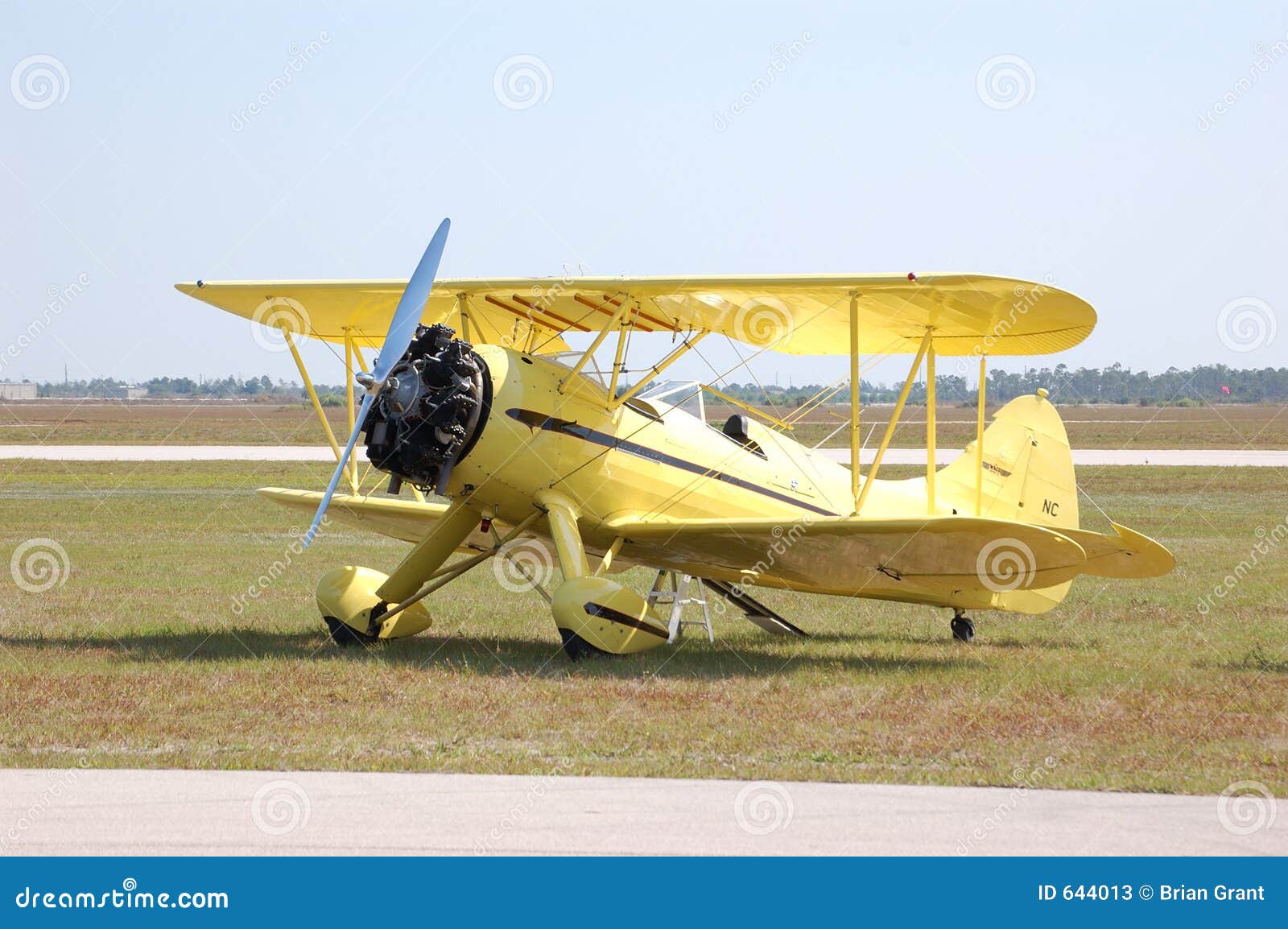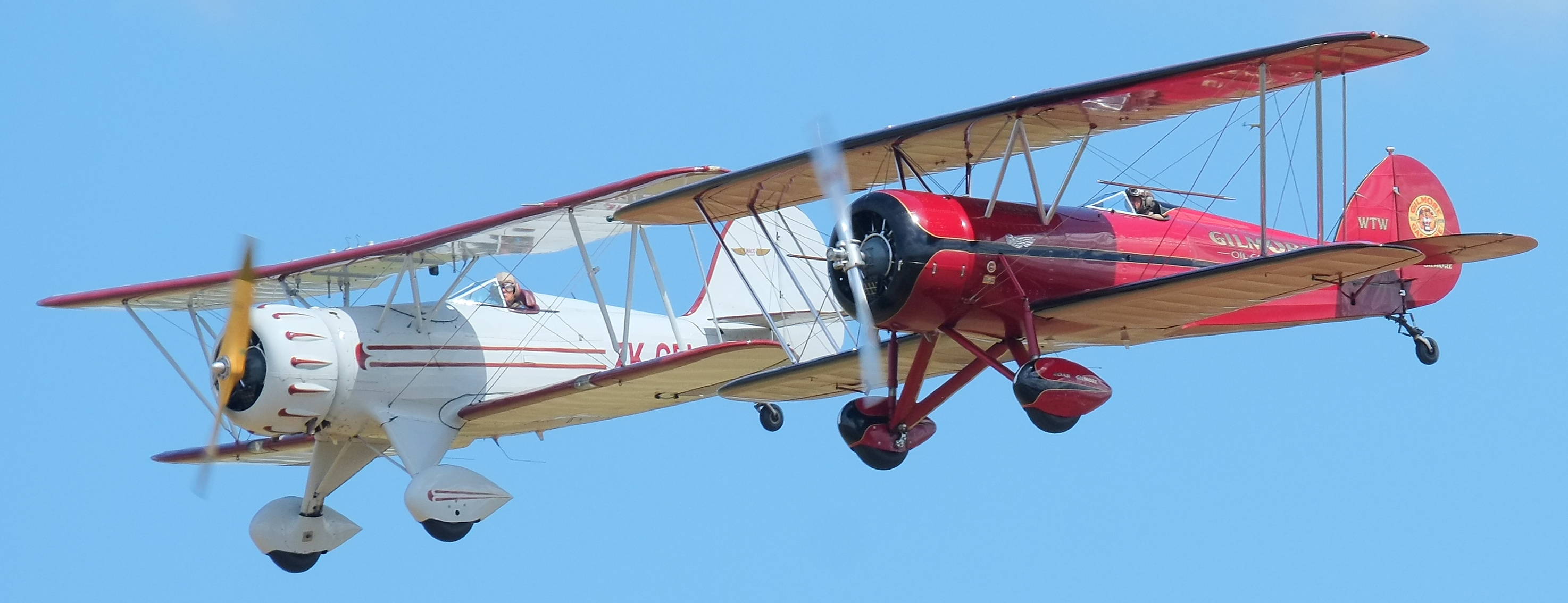Waco Aircraft Corporation - The Waco F series is a series of aeronautical and military biplane trainers built in the United States in the 1930s by the Waco Aircraft Company.
The Waco 'F' series of biplanes were superseded and replaced the earlier 'O' series of 1927/33. The "F" series features an airframe that is approximately 450 lb (200 kg) smaller and lighter than the "O" series, although it still has three people in a side-by-side cabin. Similar performance to the previous model is achieved thanks to the power of smaller and cheaper machines.
Waco Aircraft Corporation
Initial models were the INF (125 hp (93 kW) Kinner Engine), KNF (100 hp (75 kW) Kinner) and RNF (110 hp (82 kW) Warner Scarab), all with undercarriage. More sub-models followed with more powerful engines up to 225 hp (168 kW). The most powerful of the range is the ZPF of 1936/37, intended for executive use.
Waco Adds Floats
The "F" series was popular with private owner pilots for sport and other uses and continued in production until the late 1930s. The UPF-7 tandem cockpit was adopted by the Pilot Training Program Civilians and continued in production until 1942, when more than 600 aircraft were built.
The 1934 YMF was significantly redesigned with a longer and wider fuselage, larger rudder and other structural changes, and entered production in March 1986 by WACO Classic Aircraft of Lansing, Michigan as the YMF-5.
Ohio's WACO Aircraft Company Inc built three copies in December 2011, which they named the MF.
Listed in approximate chronological order (according to Simpson, 2001, p. 573) The first letter of the name refers to the gin machine installed. Since 1936, Waco has added the year suffix to the name, eg YPF-6, YPF-7, with the digit being the last digit of the model year.
Great Lakes By Waco
Two UBFs designated XJW-1 have been used by the US Navy as hook trainers for the Skyhook parasite aircraft program. Waco Aircraft Company (WACO) is an aircraft manufacturer based in Troy, Ohio, United States. From 1920 to 1947, the company produced a variety of civilian biplanes.
The company originally began as the Weaver Aircraft Company of Ohio, but changed its name to the Waco Aircraft Company in 1928/29.
Several companies operate under the Waco name, the first being the Weaver Aircraft Company, a company founded by George E. Weaver, Clayton Bruckner and Elwood Junkin in 1920 in Lorain and Medina, Ohio after working together for several years. In the spring of 1923, the company became the Advanced Aircraft Company of Troy, Ohio, after Weaver's departure.

The company is often confused with the Western Aviation Company, the name of four unrelated aircraft sites in Chicago, Illinois; San Antonio, Texas; and Burbank, California.
Waco Aircraft Corp
Waco's history began in 1919 when businessmen Clayton J. "Clayt" Brukner and Elwood "Sam" Junkin met pilots Charles "Charley" William Meyers and George "Buck" Weaver. Although their initial seaplane design was a failure, they founded the Waco company in 1920 and established themselves as a manufacturer of sturdy and reliable aircraft that were popular with customers, travel entrepreneurs, postal services and adventurers, especially after the company began producing seaplanes with closed enclosures. cabins biplane models after 1930 in addition to the op.
The Waco name was very well recorded in the civil aircraft registry of the United States between the wars, with more Waco's registered than any other company's aircraft. Production types include operating cabin biplanes, cabin biplanes, and cabin biplanes (known to Waco as custom cabins), as well as a variety of experimental types.
During World War II, Waco produced a large number of military gliders for the RAF and US Army Air Forces for airborne operations, particularly during the Normandy invasion and Operation Market Gard. The Waco CG-4 is their most prolific glider design ever produced. Simultaneously, Waco produced more than 600 operational UPF-7 biplanes and 21 VKS-7F cockpit biplanes for the Civilian Pilot Training Program, supplementing the output of military training facilities. 42 privately owned models of sixty types entered service as US Air Force light transport and utility aircraft under the common designation C-72/UC-72.
It suffered the fate of some general aviation companies when the predicted post-World War II aviation boom failed to materialize.
Waco History: 1923 1928
Waco was ultimately based on an experimental Franklin gin, with the cancellation of other contracts becoming excessive, Aristocraft, the company that relied on it, was canceled.
The Waco brand was briefly revived in the 1960s and early 1970s to plan the manufacture, assembly, assembly or marketing of a range of modern all-electric light aircraft. Italian and French metal (semi-monolithic, closed cabin, low wing). , single engine) under license in the United States. The program was headed by "Mr. Berger" and the business became known (in 1968) as Waco Aircraft Co., a subsidiary of Allied Aero Industries, Inc., and headquartered at Pottstown-Limerick Airport, Pottstown, Pennsylvania with distributors in Connecticut, Georgia, Oklahoma, Texas, California and Ontario, Canada.
The European WACOs - in some cases replacing the original Lycoming planes with less common Franklin planes (Mr. Berger is related to Franklin) - will be produced (or at least assembled or assembled) in the United States by the WACO Aircraft Company of Syracuse, New York . Only a few dozen (perhaps 65-150) of these European-origin aircraft were sold as WACOs before the death of Mr. Berger ended the program. These aircraft include:

The WACO Classic Aircraft Company (not related to the original Waco) began building the WACO Classic YMF in 1986, an updated version based on the original Waco type-certificated design.
Waco Aircraft: Making Flying Dreams Come True
A large number of surviving aircraft exist, with the largest collection located at the Historic Aircraft Restoration Museum at Dauster Field, Creve Coeur, near St Louis, Missouri.
Note: Civil Waco markings describe aircraft configuration. The first letter lists the alcohol used, the second the specific and the third the general series. The coding system was changed in 1929 with some letters reassigned, and then with the introduction of the Custom Cabin line, the original third letter 'C' was replaced by C-S (Cabin-Tire). standard) and finally S.
The numeric suffix represents the first year of manufacture if it is 6 or more (6=1936) or a subcategory if it is 2 or less. Thus, EGC-7 was a Wright R-760-E2 (350 hp (261 kW)), a custom cockpit, biplane structure first produced in 1937.
Many Waco cockpit biplanes, originally sold as civilian aircraft, entered military service during World War II. The United States Army Air Forces have classified their aircraft regardless of type as the Waco C-72, with type letters identifying specific models. Other countries have used other names for their own Wacos.
Waco Warplanes Of Latin America
Many Curtiss JN-4 parts were used with new replaceable wing panels and powered by a 90 hp (67 kW) Curtiss OX-5 engine.
The most produced Waco model, 1,623 built between 1927 and 1933. An improved version of the Waco 9 with a 90 hp (67 kW) Curtiss OX-5 V8 engine. GXE redesigned by Waco in 1928.
Versatile military export biplane with 450 hp (340 kW) Pratt & Whitney Wasp Junior SB circular engine. 1 export to Cuba

The 1935 Waco CUC shows the cockpit and enlarged windows of later C-series models. Anoka-Blaine Airport near Minneapolis, June 2006.
Waco Aircraft Ymf 5c Vh Yrb
The Waco EQC-6 Custom at the Calgary Air Museum in 1996 shows the longest glass cockpit of the late C-series aircraft. WACO Classic Aircraft Corporation is an American aircraft manufacturer, headquartered in Battle Creek, Michigan. It was founded in 1983 as Classic Aircraft Corporation and is now known as WACO Aircraft Corporation.
WACO Classic Aircraft built, in relatively small numbers, a three-seat biplane, the WACO Classic YMF, based on the initial production plans submitted by the Waco Aircraft Company to the Library of Congress and thus available. The aircraft was built at the W. K. Kellogg Airfield in Battle Creek, Michigan. The company also repairs original "vintage" WACOs and vintage aircraft.
Although the aircraft it builds is an older design, WACO Classic Aircraft has upgraded many systems, such as the brakes, to newer, safer technology. They were built using much of the original manufacturing methods and are sought after vintage cockpit aircraft, but with modern digital electronics.
So far, Waco Classic offers only one of the built-in Wacos models. In 2007 over 100 new YMF-5C aircraft were completed.
Waco Aircraft Flying From 1923 Through World War Ii
In June 2009, the company announced an improved version of the YMF-5D, powered by a 300 hp (224 kW) Jacobs R-755-A2 engine. This model received type certification in October 2009 and features a new MT-Propeller, a plush leather interior, new lightweight carbon fiber wheels and aprons, an upgraded avionics package and glass mounts.
In January 2011, the company announced that it would once again produce the Great Lakes Model 2T-1A-1/2 biplane. This aircraft has been out of service since 1980. The aircraft has a number of changes, including a larger cabin and advanced avionics. It is equipped with the Lycoming AEIO-360-B1F6 engine.
In May 2012, the company announced that the first Great Lakes production was under construction and was completed in June 2013.

Aircraft corporation, waco aircraft for sale, waco classic aircraft corporation, aircraft finance corporation, univair aircraft corporation, sikorsky aircraft corporation, cirrus aircraft corporation, aircraft guaranty corporation, waco aircraft, cessna aircraft corporation, bell aircraft corporation, united aircraft corporation

0 Comments